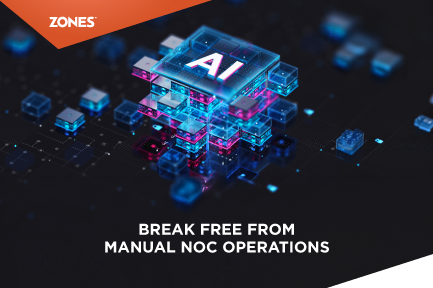Transforming the Network Operations Center with AI and Automation
IT infrastructure has become more complicated to maintain. This intricacy is caused by several reasons, as mentioned below, each of which demands...
3 min read
![]() Zones
:
Aug 22, 2023 8:16:38 AM
Zones
:
Aug 22, 2023 8:16:38 AM

Organizations rely immensely on their IT infrastructure to deliver high-quality services and products. Networks are the lifelines of businesses, and the significance of an efficient Network Operations Center (NOC) cannot be underestimated. The Network Operations Center (NOC) is the nerve center of any IT infrastructure, responsible for monitoring and managing the network and ensuring its smooth functioning. However, with the increasing complexity of IT systems, managing NOC has become daunting, requiring real-time monitoring and management to ensure optimum performance and efficiency.
The Network Operations Center (NOC) is an organization's IT infrastructure's central hub, managing and monitoring the network, servers, applications, and other related components. Real-time monitoring and management are critical to ensure the smooth functioning of the IT infrastructure, and any downtime or performance issues can have severe consequences on the organization's reputation and revenue.
As organizations continue to grow and adopt digital technologies, they encounter many complex challenges that can hinder their growth and stability. However, despite the challenges, NOCs can be a source of hope by providing solutions to help navigate these difficult situations.
As organizations expand their digital footprint, the complexity of their networks grows exponentially. Managing a vast array of devices, applications, and services becomes daunting. Real-time monitoring and management within NOCs leverage advanced tools to identify and address network complexities, ensuring seamless operations swiftly.
Poor network performance can negatively affect an organization's operations. Real-time monitoring promptly detects performance issues, enabling swift intervention to prevent disruptions and ensure consistent user experience.
The lack of insight into network activities can impede rapid decision-making. NOCs equipped with real-time monitoring provide a holistic view of the network's health, allowing organizations to make informed choices based on real-time data.
Downtime comes with a hefty price tag in terms of revenue loss and reputational damage. Real-time monitoring helps organizations preempt potential issues, avoiding costly downtime and minimizing financial impact.
The adoption of real-time monitoring and management solutions presents a transformative paradigm shift for NOCs, addressing these challenges head-on while delivering a plethora of benefits:
Real-time monitoring provides a comprehensive and up-to-the-minute view of network operations, enabling organizations to detect and diagnose issues in their infancy.
With real-time insights, IT teams can proactively address potential problems before they escalate, reducing downtime and minimizing business disruptions.
By analyzing real-time data, organizations can allocate resources more efficiently, ensuring optimal network performance without unnecessary overhead.
Real-time monitoring helps reduce operational costs by preventing downtime, enhancing efficiency, and streamlining resource allocation.
Leveraging AI and ML, organizations can harness the power of predictive analytics to forecast potential issues, allowing them to take preventive measures and maintain seamless operations.
Real-time solutions are designed to scale with business growth, ensuring that the network can handle increasing demands and adapt to changing requirements.
As companies adopt a digital transformation posture and technology becomes more integrated into every aspect of their operations, the significance of real-time NOC monitoring only increases. By investing in a state-of-the-art monitoring solution, organizations can future-proof their networks, ensuring they remain agile, responsive, and adaptable in the face of evolving challenges.
Predictive analytics will play a pivotal role, enabling organizations to anticipate and address issues before they impact operations. Moreover, integrating real-time monitoring with IoT devices will amplify the scope of NOC capabilities, fostering a more interconnected and resilient digital ecosystem.
The transition towards real-time monitoring and management within the NOC demands a strategic approach:
Select and integrate advanced monitoring tools tailored to your network's complexity and requirements.
Develop real-time monitoring strategies for proactive issue detection and resolution.
Train IT teams to utilize monitoring tools and respond swiftly to alerts.
Regularly assess and refine your real-time monitoring strategy to keep up with evolving network dynamics.
Real-time monitoring and management of NOC are critical to ensuring the smooth functioning of an organization's IT infrastructure and can provide increased productivity, reduced downtime, and enhanced security. It transforms network management from a reactive endeavor into a proactive, data-driven strategy. This revolutionary approach empowers businesses to stay ahead of the curve and offer outstanding user experiences with instant insights and optimized performance.

IT infrastructure has become more complicated to maintain. This intricacy is caused by several reasons, as mentioned below, each of which demands...

Managing IT infrastructure and operations is challenging and is often decentralized and fragmented. How can organizations achieve efficiency,...

As we all turn the page on 2020 and look ahead to 2021, now is a time to set resolutions for the new year. In your personal life, this may mean...